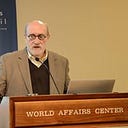The Lost City of the Monkey God
In 2015, an expedition led by an American filmmaker ventured deep into the Honduran rain forest in search of a fabled ancient city known variously as The White City and The Lost City of the Monkey God. The novelist and nonfiction writer Douglas Preston accompanied the expedition on assignment from the National Geographic. He adopted the lengthier name of the long-lost town as the title of his fascinating first-person account of the journey. The book reads like a thriller, but it is, as the subtitle insists, a true story.
Conventional wisdom has it that the only places unexplored by the human race are at the bottom of the oceans and in outer space. However, that’s simply not true. Deep in the jungles of Central America, the Amazon, and sub-Saharan Africa lie extensive stretches of territory that have never been entered by our contemporaries — and, in some cases, perhaps by any human being at all. Gradually in recent years, a combination of 21st-century technology, obsessive explorers, and the public’s insatiable hunger for adventure stories has uncovered “lost civilizations” in some of these places. Less than a decade ago, a nonfiction book by David Grann told the story of one such successful search in The Lost City of Z: A Tale of Deadly Obsession in the Amazon. Now Douglas Preston relates the 20-year search of another obsessive man who explored the Central American rainforest.
Most of us think of the Maya in connection with that region. This pre-Columbian civilization is one of the most studied societies on the planet. Preston’s book introduces us to another early society in the region contemporaneous with the Maya. Hitherto only the subject of rumor and legend, the people of this society have yet to be assigned a name by archaeologists. Their cities were buried so deeply in the rainforest that no one had set foot in them for five centuries. However, the evidence uncovered by the expedition Preston chronicles in his book establish without doubt that these people existed — and that they were both numerous and accomplished. This is an exciting tale, well-researched and well written.
Roughly speaking, Preston’s book consists of three parts. In the first part, he relates the legend of The Lost City of the Monkey God. Archaeologists had long discounted the tale because most of those who claimed to have been to the city were charlatans. Very few legitimate scientists had ever attempted to find the place, and they all failed.
In the book’s second part, Preston tells the story of the 2015 expedition and its follow-up. What made the new expedition possible was a top-secret technology developed by the US Department of Defense — an advanced form of lidar, a ground-penetrating method similar to radar that permitted the explorers to see evidence of human habitation even under a seemingly impenetrable rainforest. Preston’s description of the technology and its application is engrossing.
Part three explores the probable cause of the sudden disappearance of the lost civilization around 1500: epidemic disease brought by Columbus and those who followed him. An earlier book, 1493: Uncovering the New World Columbus Created, by Charles C. Mann, explains how European diseases devastated the people of the New World. Preston refers to later evidence cited by scientists that the advent of the Europeans reduced the population of both continents by some 90 percent.
Preston also explores the broader topic of tropical diseases and their inexorable march northward as a result of climate change. He pays special attention to a potentially fatal parasitic illness called leishmaniasis, which is endemic in the Third World. Every member of the 2015 expedition was exposed to leishmaniasis, and half of them contracted the disease, including Preston himself. Now leishmaniasis has made its way into the United States and is steadily moving to the north as the planet continues to warm.
About the author
Douglas Preston has written 30 novels, four of them in partnership with Lincoln Child, as well as nine nonfiction books other than The Lost City of the Monkey God. He has been writing full-time for 30 years. Preston is perhaps best known as the coauthor of The Monster of Florence, a nonfiction portrayal of the unsolved murders committed by an Italian serial killer. He is the brother of bestselling nonfiction author Richard Preston, author of The Hot Zone and other books.
